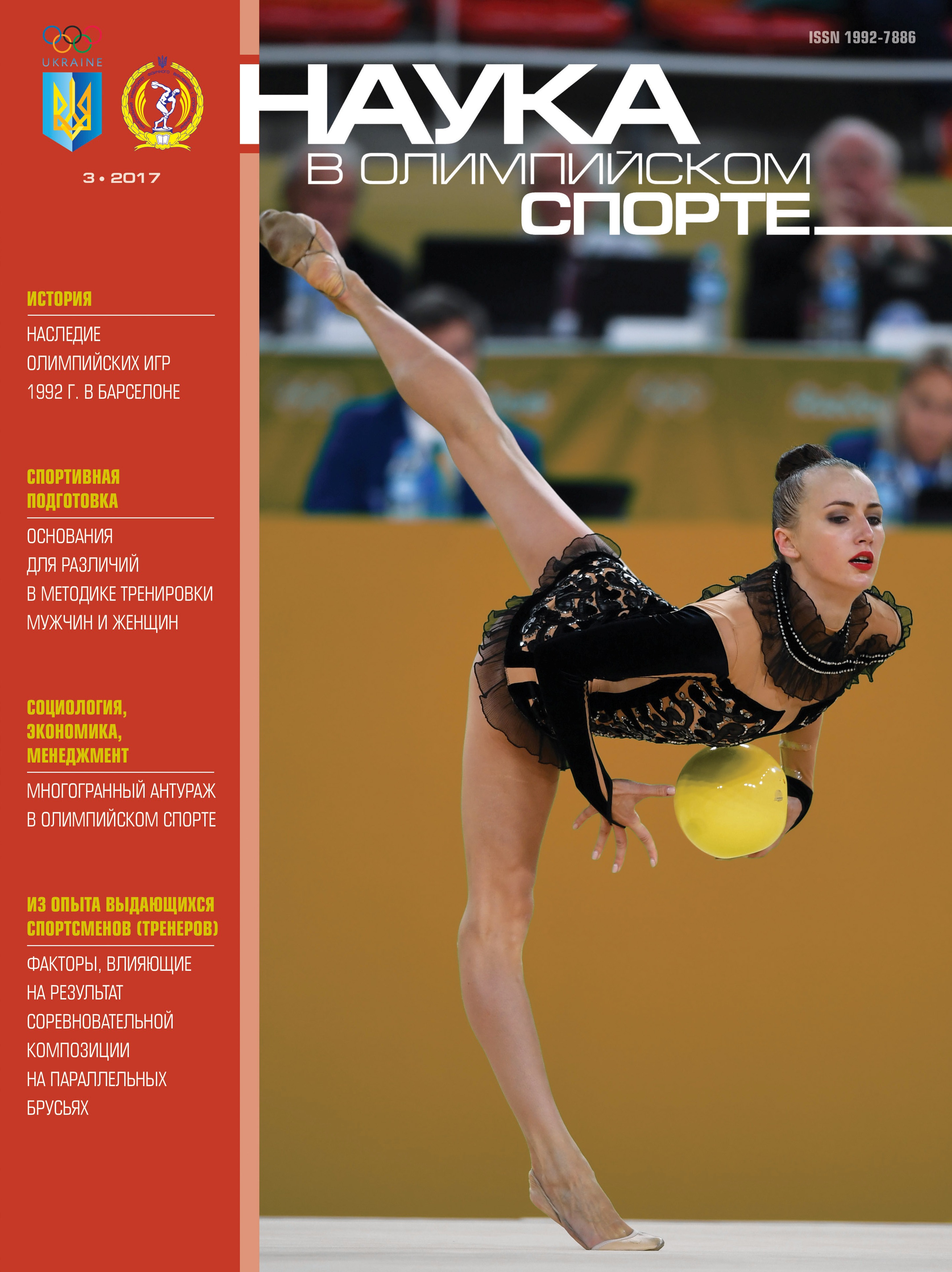Биомеханические особенности техники толчка штанги у квалифицированных спортсменок
DOI:
https://doi.org/10.32652/olympic2017.3_%25xКлючевые слова:
биомеханическая характеристика структуры движения, толчок штанги, реализация соревновательного упражнения, модель техники, весовые категории, квалифицированные спортсменкиАннотация
В статье рассмотрена проблема влияния биомеханических характеристик техники толчка штанги у квалифицированных тяжелоатлеток разных групп весовых категорий на результативность их соревновательной деятельности. Особое внимание уделено анализу биомеханической структуры техники толчка штанги у спортсменок трех групп весовых категорий, которая регистрировалась нами в «контрольной» зоне интенсивности (масса штанги 92-100 % максимального) в процессе соревновательной деятельности при двух условиях реализации соревновательного упражнения: успешная и неуспешная. Предпринята попытка раскрыть причины технических ошибок, допущенных спортсменками разных групп весовых категорий в подъеме штанги от груди, особенно при незавершенных соревновательных упражнениях, и влияние биомеханических характеристик на двигательную структуру снаряда. Получены достоверные различия в биомеханических характеристиках техники толчка у спортсменок разных весовых категорий, большая часть которых связана с нарушением динамической, а следовательно, и кинематической структуры движения штанги, что указывает на необходимость систематической ее коррекции.Библиографические ссылки
Antoniuk OV. Improving technical preparedness of elite female weightlifters with different constitution [avtoreferat]. Kiev; 2012. 23 p.
Gamaliy VV. Biomechanical aspects of the technique of motor actions in sports. Kyiv: Nauk. Svit; 2007. 225 p.
Ivanov AV. Improvement of the barbell jerk technique in qualified weightlifters on the basis of the variation in the load [avtoreferat]. Kiev; 2015. 21 p.
Loiasa DLE. Correction of the technique of jerk execution in highly qualified weightlifters on the basis of biomechanical analysis of compensated mistakes [avtoreferat]. St. Petersburg: Lesgaft National State University of Physical Education, Sport and Health; 2012. 24 p.
Maliutina AN. The importance of the rhythmic-temporal structure in the jerk technique in female weightlifters [avtoreferat]. Malakhovka: Moscow State Academy of Physical Culture; 2008. 24 p.
Medvedev АS. Biomechanics of classic snatch and clean and jerk, as well as of specialpreparatory snatch and clean and jerk exercises: monograph. Izhevsk: Olimp Ltd.; 1997. 132 p.
Mocherniuk VB. Models of fitness of highly qualified weightlifters [avtoreferat]. Lviv: Lviv State University of Physical Culture; 2013. 20 p.
Oleshko VG. Biomechanical characteristics of technical and tactical actions of elite weightlifters in competitive exercises in view of modeling their components. Science in Olympic Sport. 2014;3:21-32.
Oleshko VG, Ivanov A, Priimak S. Improvement of technical preparation of elite weightlifters by variation in the magnitude of the load. Science in Olympic Sport. 2016;2:57-63.
Platonov VN. The system for preparing athletes in Olympic sport. General theory and its practical applications: [textbook for coaches]: in 2 vols. Кyiv: Olympic literature; 2015. Vol. 1; 680 p.; Vol. 2.; 752 p.
Poletaiev PA. Modeling of kinematic characteristics of the competitive exercise “snatch” in elite weightlifters [avtoreferat]. Moscow: Russian State University of Physical Education; 2006. 22 p.
Tyo SY. Biomechanics of weightlifting exercises depending on the somatotype. Theory and practice of physical culture. 2009;9:66–67.
Tovstonog OF. Individualization of technical preparation of weightlifters at the stage of specialized basic training [avtoreferat]. Lviv: Lviv State University of Physical Culture; 2012. 20 p.
Shalmanov A, Skotnikov V, Panin A. Kinematics and dynamics of the barbell movements performed by elite weightlifters in conditions of competitions. Olymp. 2012;2-3:27-31.
Yust VV. Increasing the reliability and effectiveness of competitive activities of weightlifters in the barbell jerk [avtoreferat]. Khabarovsk; 2006. 19 p.
Campos J, Poletaev P, Cuesta A, Pablos C, Carratalá V. Kinematical analysis of the snatch in elite male junior weightlifters of different weight categories. J. of Strength Conditioning Research. 2006;20(4):843-850.
Donald LH, Kevin M, Bryan K, Carlоse J. Biomechanical analysis of the women weightlifters during the snatch. J. of Strength Conditioning Research. 2006;20(3):627-633.
Garhammer J, Komi PV. Weightlifting performance and techniques of men and women. In: Proceedings from the International Conference on Weightlifting and Strength Training. Lahty, Finland; 1998. p. 89-94.
Gourgoulis V, Aggelousis N, Mavromatis G. Snatch lift kinematics and bar energetics in male adolescent and adult weightlifters. Journal of Sport Medicine and Physical Fitness. 2004;44(2):126-131.
Harbili EA. Gender-bases kinematic and kinetic analysis of the snatch in the elite weightlifters in 69-kg category. Journal of sport and medicine. 2012;11:162-169.
Isaka Т, Okada J, Funato K. Kinematic Analysis of the barbell during the snatch movement of Elite Asian weightlifters. J. of Appl. Biomechanics. 1996;12:508-516.
Okada J, Iijima K, Kikuchi T, Kato K. Kinematics analysis of the snatch technique used by Japanese and international female weightlifters at the 2006 Junior World Championships. International J. of Sport and Health Sci. 2008;6:194-202.
Оleshko V. Dynamics of biomechanical structure of highly qualified weightlifters clean and jerk depending on sex and weight category. European Researcher. 2013;58(9-1):2227-2240.
Yang C, Li W, Gu Z. Biomechanical analysis of snatching skills women topnotch weight lift. In: 18-th International Symposium biomechanical in sport. Konstanz, Germany; 2000. p. 380-382
Загрузки
Опубликован
Выпуск
Раздел
Лицензия
Copyright (c) 2018 Наука в олимпийском спорте

Это произведение доступно по лицензии Creative Commons «Attribution-NonCommercial» («Атрибуция — Некоммерческое использование») 4.0 Всемирная.
Все статьи открытого доступа распространяются под терминами Creative Commons Attribution-NonCommercial 4.0 International License , которая позволяет другим людям перерабатывать, поправлять и брать статьи за основу для производных в некоммерческих целях. Новые произведения должны размещаться с указанием авторства и распространяться на некоммерческой основе, лицензирование производных на тех же условиях не обязательно.
, которая позволяет другим людям перерабатывать, поправлять и брать статьи за основу для производных в некоммерческих целях. Новые произведения должны размещаться с указанием авторства и распространяться на некоммерческой основе, лицензирование производных на тех же условиях не обязательно.

